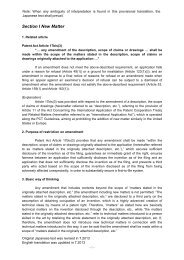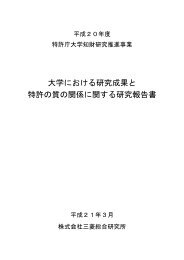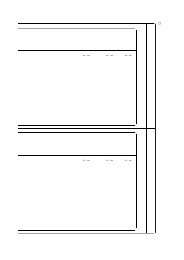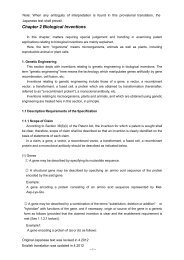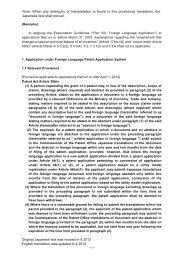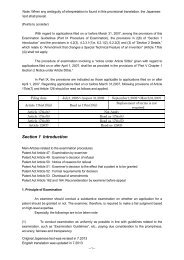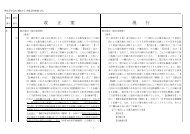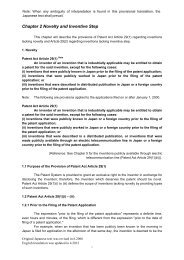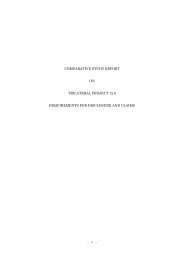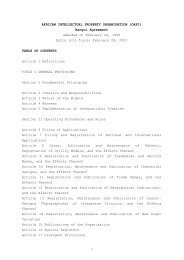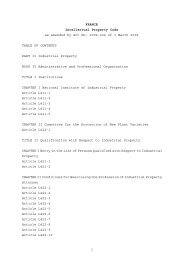Requirements for Unity of Application - Japan Patent Office
Requirements for Unity of Application - Japan Patent Office
Requirements for Unity of Application - Japan Patent Office
You also want an ePaper? Increase the reach of your titles
YUMPU automatically turns print PDFs into web optimized ePapers that Google loves.
[Example 19]<br />
[Title <strong>of</strong> the Invention]<br />
Ceramic material and process <strong>of</strong> dissolving the core made <strong>of</strong> said material<br />
[Claims]<br />
1. A means <strong>of</strong> dissolving a ceramic material from an article vulnerable to attack by a caustic<br />
alkaline solution, characterized in that a substance containing hydrogen donors in the<br />
ceramic material is included, and the ceramic material is immersed in anhydrous caustic<br />
alkaline solution.<br />
2. A means <strong>of</strong> dissolving a core made <strong>of</strong> a ceramic material <strong>of</strong> a light metal or a light alloy<br />
casting, wherein a light metal or a light alloy casting having a core consisting <strong>of</strong> a ceramic material<br />
including a substance with the hydrogen donors is contacted to anhydrous caustic alkali to be<br />
immersed in the anhydrous caustic alkali melted by the heat <strong>of</strong> a casting be<strong>for</strong>e said the<br />
casting gets cold.<br />
[Excerpt from Detailed Description <strong>of</strong> the Invention]<br />
This invention relates to the process <strong>of</strong> dissolving a ceramic material and the core made <strong>of</strong><br />
said material <strong>of</strong> an article that is vulnerable to attack by a caustic alkaline solution.<br />
Although the core made from a ceramic material <strong>of</strong> the alloy casting is mainly manufactured<br />
from nickel, and cobalt is fundamentally dissolved and extruded in a caustic alkaline solution,<br />
this process cannot be applied to light metals or light alloy castings because they are impinged<br />
on by a caustic alkaline solution. By making a ceramic material containing hydrogen donors, the<br />
present invention has made it possible to dissolve just a ceramic material selectively without<br />
light metals or light alloy castings being impinged on in the anhydrous alkaline solution.<br />
Furthermore, to “bring the casting into contact with an anhydrous alkali be<strong>for</strong>e the casting cools<br />
down”, as described in Claim 2, aims at dissolving the anhydrous alkali by making use <strong>of</strong> the<br />
heat from a casting.<br />
[Explanation]<br />
The technical field <strong>of</strong> the specified invention (Claim 1) is “dissolving a ceramic material in an<br />
article which is vulnerable to attack by a caustic alkali solution “, whereas that <strong>of</strong> the related<br />
invention (Claim 2) is “dissolving the core made <strong>of</strong> a ceramics material <strong>of</strong> a light metal or a light<br />
alloy casting”. Light metals or light alloys are vulnerable to attack by a caustic alkali solution, and<br />
it is highly appropriate that the technology <strong>of</strong> the specified invention should be applied to the<br />
dissolution <strong>of</strong> the core, which is made <strong>of</strong> a ceramic material, <strong>of</strong> said casting <strong>of</strong> the materials.<br />
There<strong>for</strong>e, the technical fields <strong>of</strong> both inventions are technically and directly associated with<br />
each other and the industrial fields <strong>of</strong> application <strong>of</strong> the inventions are also the same.<br />
On the other hand, the new matter corresponding to the problems to be solved <strong>of</strong> the<br />
specified invention, i.e. to “make a ceramic material include the substance containing hydrogen<br />
donors and make a ceramic material immerse in the anhydrous caustic alkaline solution”, is<br />
equivalent to the substantial part <strong>of</strong> the matters in the claim <strong>of</strong> the related invention. There<strong>for</strong>e,<br />
the substantial parts <strong>of</strong> matters in the claims <strong>of</strong> the two inventions are the same.<br />
[Concerned Section]<br />
<strong>Patent</strong> Law Section 37(ii)<br />
47



